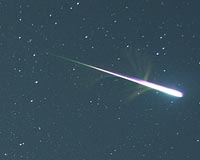 |
Pasadena CA (JPL) Oct 20, 2010 Backyard stargazers with a telescope or binoculars and a clear night's sky can now inspect the comet that in a little over two weeks will become only the fifth in history to be imaged close up. Comet Hartley 2 will come within 17.7 million kilometers (11 million miles) of Earth this Wed., Oct. 20 at noon PDT (3 p.m. EDT). NASA's EPOXI mission will come within 700 kilometers (435 miles) of Hartley 2 on Nov. 4. "On October 20, the comet will be the closest it has ever been since it was discovered in 1986 by Australian astronomer Malcolm Hartley," said Don Yeomans, head of NASA's Near-Earth Object Office at the Jet Propulsion Laboratory in Pasadena, Calif. and a member of the EPOXI science team. "It's unusual for a comet to approach this close. It is nice of Mother Nature to give us a preview before we see Hartley 2 in all its cometary glory with some great close-up images less than two weeks later." Comet Hartley 2, also known as 103P/Hartley 2, is a relatively small, but very active periodic comet that orbits the sun once every 6.5 years. From dark, pristine skies in the Northern Hemisphere, the comet should be visible with binoculars as a fuzzy object in the constellation Auriga, passing south of the bright star Capella. Viewing of Hartley 2 from high ambient light locations including urban areas may be more difficult. In the early morning hours of Oct. 20, the optimal dark sky window for mid-latitude northern observers is under two hours in length. This dark interval will occur between the time when the nearly-full moon sets at about 4:50 a.m. (local time) and when the morning twilight begins at about 6:35 a.m. By October 22, the comet will have passed through the constellation Auriga. It will continue its journey across the night sky in the direction of the constellation Gemini. EPOXI is an extended mission that utilizes the already "in-flight" Deep Impact spacecraft to explore distinct celestial targets of opportunity. The name EPOXI itself is a combination of the names for the two extended mission components: the extrasolar planet observations, called Extrasolar Planet Observations and Characterization (EPOCh), and the flyby of comet Hartley 2, called the Deep Impact Extended Investigation (DIXI). The spacecraft will continue to be referred to as "Deep Impact." JPL manages the EPOXI mission for NASA's Science Mission Directorate, Washington. The University of Maryland, College Park, is home to the mission's principal investigator, Michael A'Hearn. Drake Deming of NASA's Goddard Space Flight Center, Greenbelt, Md., is the science lead for the mission's extrasolar planet observations. The spacecraft was built for NASA by Ball Aerospace and Technologies Corp., Boulder, Colo. Images and videos of comet Hartley 2 from both amateur observers and major observatories are online here.
Share This Article With Planet Earth
Related Links EPOXI Asteroid and Comet Mission News, Science and Technology
 Raining Halley
Raining HalleyHuntsville AL (SPX) Oct 19, 2010 The most famous of all comets, Comet Halley is noted for producing spectacular displays when it passes near Earth on its 76-year trip around the sun. However, you don't have to wait until 2061 to see a piece of the comet - you can do it this very week! Halley's Comet leaves bits of itself behind - in the form of small conglomerates of dust and ice called meteoroids - as it moves in its orb ... read more |
|
| The content herein, unless otherwise known to be public domain, are Copyright 1995-2010 - SpaceDaily. AFP and UPI Wire Stories are copyright Agence France-Presse and United Press International. ESA Portal Reports are copyright European Space Agency. All NASA sourced material is public domain. Additional copyrights may apply in whole or part to other bona fide parties. Advertising does not imply endorsement,agreement or approval of any opinions, statements or information provided by SpaceDaily on any Web page published or hosted by SpaceDaily. Privacy Statement |